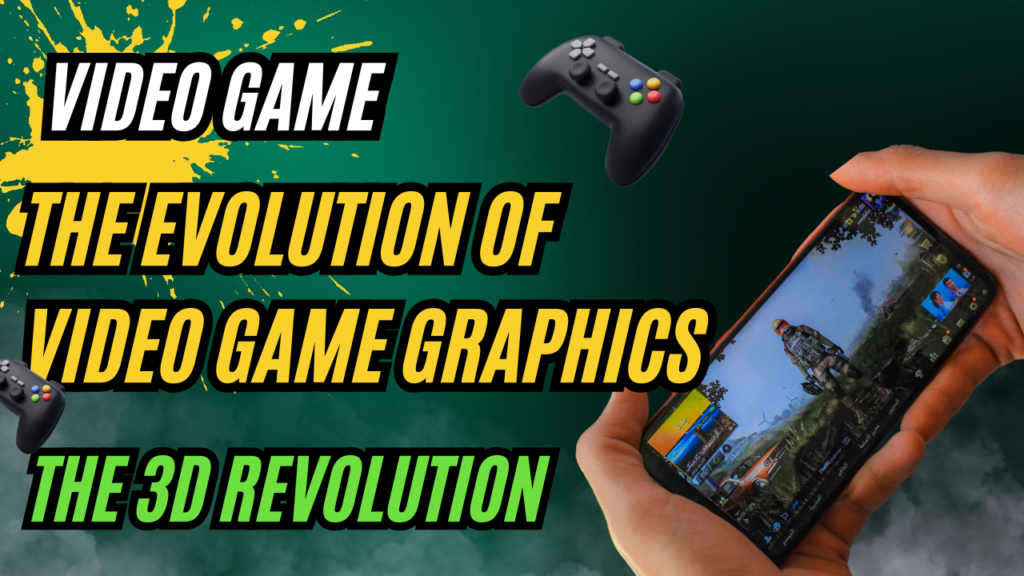Video game graphics have undergone a remarkable transformation since the industry’s inception. From simple pixelated sprites to stunningly realistic 3D environments, advancements in technology and artistry have significantly enhanced the visual experience for players. This article explores the evolution of video game graphics, highlighting key milestones, technological innovations, and the impact on gameplay and player immersion.
The Beginnings: 8-Bit Graphics
The Birth of Video Games
The journey of video game graphics began in the early 1970s with the launch of simple arcade games like “Pong.” These early games featured minimal graphics, relying on basic shapes and monochrome displays. However, by the late 1970s and early 1980s, the introduction of 8-bit consoles, such as the Atari 2600, revolutionized graphics.
Iconic Titles and Their Graphics
Games like “Super Mario Bros.” (1985) and “The Legend of Zelda” (1986) showcased the potential of 8-bit graphics. With a limited color palette and pixelated sprites, these games created iconic characters and worlds that remain beloved today. Despite the technological limitations, creativity flourished, setting the stage for future advancements.
The 16-Bit Era: Enhanced Visuals and Sound
The Rise of the SNES and Sega Genesis
The transition to 16-bit graphics in the early 1990s marked a significant leap forward. Consoles like the Super Nintendo Entertainment System (SNES) and Sega Genesis introduced richer colors and more detailed sprites. Games like “Street Fighter II” (1991) and “Sonic the Hedgehog” (1991) demonstrated the capabilities of 16-bit graphics, offering vibrant visuals and smoother animations.
Parallax Scrolling and Mode 7
Innovative techniques such as parallax scrolling and Mode 7 enhanced the visual experience. Parallax scrolling created the illusion of depth by moving background layers at different speeds, while Mode 7 allowed for the manipulation of 2D sprites in a 3D space. These advancements provided a more immersive experience and laid the groundwork for future graphic innovations.
The 3D Revolution: Moving into the Third Dimension
The Introduction of 3D Graphics
The mid-1990s ushered in the 3D revolution, propelled by advancements in computer technology. Titles like “Doom” (1993) and “Quake” (1996) showcased the power of 3D graphics, utilizing polygons to create environments and characters. This shift fundamentally changed how games were designed and played.
Real-Time Rendering and Texture Mapping
Real-time rendering techniques allowed for dynamic graphics that changed as players interacted with the game world. Texture mapping added realism by applying images to 3D models, creating more detailed surfaces. Games like “Final Fantasy VII” (1997) and “The Legend of Zelda: Ocarina of Time” (1998) exemplified the potential of 3D graphics, offering vast worlds and immersive storytelling.
The Dawn of High-Definition Graphics
The Transition to HD
The introduction of high-definition (HD) graphics in the mid-2000s marked another turning point in video game visuals. Consoles like the PlayStation 3 and Xbox 360 supported HD resolutions, allowing developers to create stunning visuals with intricate details and realistic lighting effects.
Advances in Animation and Character Design
Games such as “Gears of War” (2006) and “Uncharted: Drake’s Fortune” (2007) showcased the capabilities of HD graphics. Improved character animations and facial expressions brought characters to life, enhancing emotional engagement. The use of motion capture technology allowed developers to create lifelike movements, further blurring the lines between gaming and reality.
The Era of Photorealism
Pushing the Boundaries of Realism
As technology advanced, the pursuit of photorealism became a primary goal for many developers. The release of consoles like the PlayStation 4 and Xbox One in the early 2010s provided the processing power necessary to create near-photorealistic graphics. Games such as “The Last of Us” (2013) and “Battlefield 4” (2013) pushed the boundaries of what was visually possible.
The Impact of Lighting and Shadows
Realistic lighting and shadow techniques, such as dynamic lighting and global illumination, significantly enhanced the visual fidelity of games. These advancements created more immersive environments, where players could experience day-night cycles and weather changes, making the virtual worlds feel alive.
The Rise of Virtual and Augmented Reality
Expanding the Gaming Experience
Virtual reality (VR) and augmented reality (AR) have introduced new dimensions to video game graphics. VR headsets like the Oculus Rift and HTC Vive offer immersive experiences that transport players into fully realized 3D worlds. AR games, such as “Pokémon GO” (2016), blend the virtual and real worlds, allowing players to interact with digital elements in their environment.
Challenges in VR Graphics
While VR presents exciting opportunities, it also poses unique challenges for graphics development. Maintaining a high frame rate and reducing latency is crucial for preventing motion sickness and ensuring a smooth experience. Developers must balance visual fidelity with performance, creating engaging experiences that feel natural and immersive.
The Future of Video Game Graphics
Emerging Technologies
The future of video game graphics promises even more innovations. Technologies such as ray tracing, which simulates the behavior of light for realistic reflections and shadows, are becoming more accessible. Games like “Cyberpunk 2077” (2020) have begun to utilize ray tracing, offering stunning visual effects that enhance immersion.
The Role of Artificial Intelligence
Artificial intelligence (AI) is also set to play a significant role in the evolution of graphics. AI can automate tasks such as texture generation and animation, allowing developers to create more detailed environments in less time. As AI technology advances, it will undoubtedly impact the way graphics are created and experienced.
Conclusion: The Ongoing Evolution of Video Game Graphics
The evolution of video game graphics reflects the broader advancements in technology and artistry over the past several decades. From 8-bit sprites to photorealistic environments, each stage of development has brought new possibilities for creativity and storytelling. As we look to the future, innovations in graphics technology, including VR, AR, and AI, will continue to shape the gaming landscape.
As players, we can look forward to ever more immersive experiences that push the boundaries of what is possible in video games. The journey of video game graphics is far from over, and the next chapter promises to be just as exciting.
